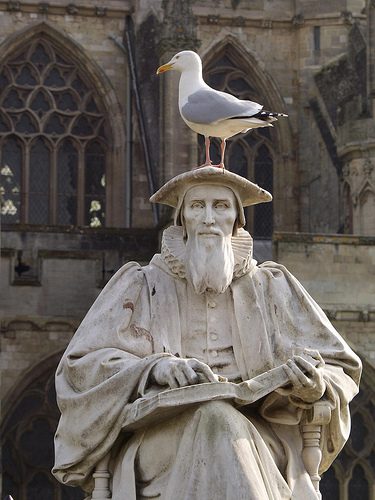Today, the 3rd of November, the Anglican communion honors Richard Hooker, priest and theologian in its calendar of feasts.
He was a central figure in the establishment of Anglicanism as a via media, a middle way between Catholicism and Protestantism. Hooker was also a beautiful writer.
He articulated a “threefold cord not quickly broken” of Bible, church, and reason. It would evolve with Anglicanism into the “three-legged stool” of scripture, tradition, and reason.
(The historical nitpickers among us, okay, me as well, point out he almost certainly did not see a triangle of equal power but a clear hierarchy, with scripture as the base, tradition where that wasn’t clear, and reason for anything else.)
For me Richard Hooker is particularly important for the third thing, and with it his fierce defense of reason in matters religious. One might even say the dove, or, perhaps it was a pigeon (as in the attached image) rested on him and he spoke with tongues of fire.
As I see it that trinity as equal parts is neither a cord nor a stool, but something dynamic, interdependent and interpenetrating which taken together can birth lives of value. And particularly important because it is a potentially powerful way for engaging any religion.
For me his three-legged stool speaks profoundly to how best engage Zen.
Tradition:
The received wisdom. For me it is Buddhism. And I believe Buddhism’s received wisdom is best summarized with the Four Seals: First, everything made of parts will come apart. And, everything is made of parts. The universe and every blessed thing in it arises, exists, and comes apart in a play of causes and conditions. Second, this constantly moving universe manifests as a tension, a vibration, if you will. And, this is experienced by human beings as a sense of dis-ease, unsatisfactoriness, anxiousness rising for many to anguish. Third, no thing is a thing. Nothing has a permanent essence. It is all the play of cause and effect. And, fourth: There is the possibility of setting the heart at rest, a peace that passes all understanding.
Scripture: As a Zen Buddhist, fitting into the larger Mahayana Dharma family, the vast collection of sacred texts are mine. However, as a Zen person, the texts to which I find myself called most accountable to are the Prajanaparamita cycle, the great koan anthologies, and the received teachings of the masters of my tradition. I believe I have some need to attend to the great texts the Flower Ornament and the Lotus Sutra and the Prajnaparamita Cycle, especially for me the Heart Sutra. And, again, as part of the Zen tradition, I have some affinity to the classics of the Taoist and Confucian traditions.
Reason: A rich, rich word, with several necessary meanings. In one way I think of the Chinese character “De” as used in the Tao de Ching. In some early translations the character is rendered as “reason.” But it also is rendered as “virtue,” “integrity,” and “morality.” Add in our Western use of reason as “the power of logic,” and I believe we begin to see what reason can be. It is both knowledge and integrated presence. In our experience it is now one, now the other. As a Zen person it points to the deeper nuances of the practices of presence gifted in our tradition: just sitting and koan introspection. Each bring our mind toward intimacy and clarity.
All three need each other. None works all by itself.
But, taken together.
A way for the heart…













